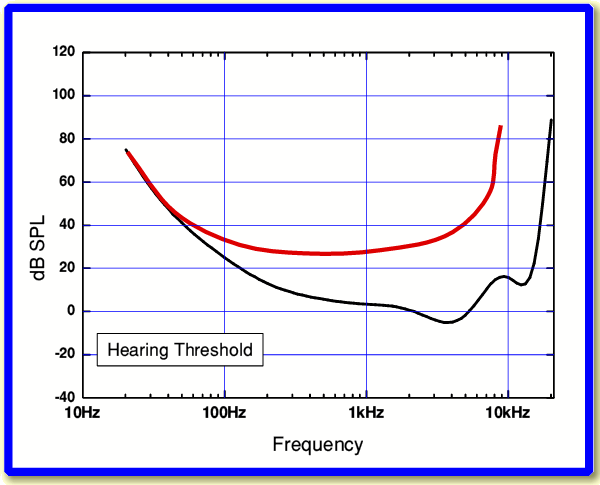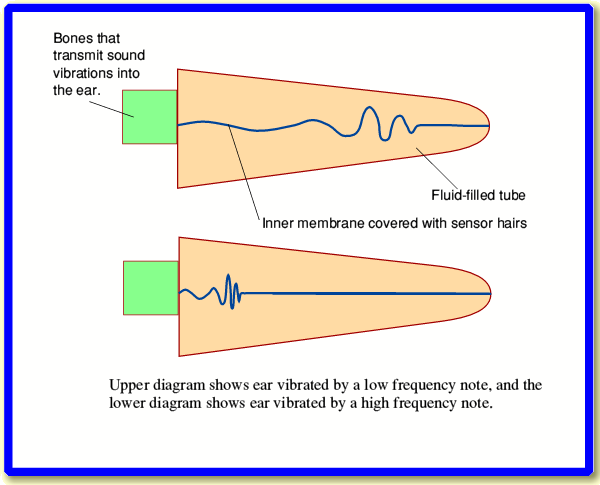Hearing Deterioration and Speech Intelligibility
This webpage is taken from an article I wrote for Living With Technology magazine.
As a result it makes passing references to other articles in that magazine.
As time passes, two processes seem inevitable. One is that there is a tendency for ‘better’ audio systems to come onto the market. The other is that our individual hearing tends to degrade. This raises two areas which it is worth considering in the context of Living with Technology. One is to understand the relative performance of various audio systems and determine when they may be ‘good enough’ for our purposes. The other is to assess the effects of changes to hearing and see what might be done to improve our ability to hear. Here I’ll deal with the basic properties of hearing and hearing loss and look at audio systems in a later article.
When in good condition human hearing can be astonishingly sensitive. Unfortunately, as we grow older, or become ill, or allow our hearing to become damaged, this sensitivity can decline. This process can be so slow and subtle as to go un-noticed at first, but the loss may be severe in some cases and end up impairing the ability to enjoy music or recognise speech.
Human hearing is quite complex, so there are a number of slightly different ways we can use to indicate its sensitivity and discrimination. The above graphs show the results of typical measurements using low-level narrow-band noise. The black line indicates the level of the quietest sounds that can just be heard in ideal conditions when tests are carried out on someone who has excellent hearing. The red line shows the kind of results we might get when someone’s hearing has deteriorated. Note that the black line is a result based upon averaging many measurements of hearing, but the red line is just an example of the kind of deteriorations that may occur.
The vertical axis is logarithmic (plotted in decibels) – so 30 dB corresponds to a sound 1,000 times more powerful than 0 dB, and 60 dB to a sound 1,000,000 times more powerful than 0 dB. The 0 dB SPL (Sound Pressure Level) level corresponds to a sound pressure of 20 micro-Newtons per square metre. Around 120 dB SPL is the loudest sustained sound level we can hear without experiencing pain and risking serious immediate damage.
Note that both the black line is only ‘typical’ for hearing in good condition. The actual sensitivity, and how it depends upon frequency will vary from one person to another. It will also vary with time of day, how alert or tired the person may be, etc. Females tend to have more sensitive hearing than males, and young people (20 years old or younger) tend to have more sensitive hearing than older people. Food and drink also have an effect!
Looking first at the black curve we can see that ‘good hearing’ will be quite sensitive over the range from about 100Hz up to 15kHz, and is especially sensitive in the region around 3 - 5 kHz. As we approach about 20kHz the sound level required for a sound to be heard rises swiftly. This curve is why we tend to regard human hearing as roughly being sensitive to the range from 20Hz to 20kHz, although some people – especially the very young – can often hear above 20 kHz.
The red curve shows two general changes. The first is that the threshold has rised by about 20 - 30 dB over most of the range between a few hundred Hz and a few kHz. This means that sounds would now need to be 20 - 30 dB louder in general (i.e. between a 100 and 1,000 times more powerful) before they would be noticed. The second is that the high frequency ‘cliff’ above which hearing fails has moved down from about 20 kHz to below 10 kHz. These are changes which are typical of three situations:
- Age! As we get older there is a tendency for our ears to become less sensitive, and to lose the ability to hear very high frequencies. This process can occur gradually over many years and at first the changes tend to be small. Hence the effects can pass un-noticed for some years.
- Illness. Some illnesses can upset the functioning of the ears and induce these sorts of changes. In many cases this may be temporary, but in some cases the damage may be enduring.
- Mechanical damage. This occurs as a result of being subjected to loud sounds. In some cases this is an industrial injury as a result of being forced to work in a noisy environment. In other cases it is the result of a deliberate choice to listen to deafeningly loud (literally!) music. Subjecting someone to sounds this loud is actually illegal, but common nevertheless.
An increase of only around 10 - 20 dB in the threshold level don’t normally affect our ability to hear speech. Nor does loss of the ability to hear above about 10 kHz. Surprisingly, neither do changes of this magnitude stop us listening to music in most cases. This is why people may often not initially notice the changes due to age. However once the change in threshold is more than about 30 - 40 dB and/or the high frequency loss reaches well below 10 kHz, then the effects become much more noticeable. Once this occurs some remedial action becomes required.
In fact the actual situation is much more complex than this as a result of the way human hearing functions. To understand this we can make use of a diagram of the relevant parts of our hearing system.
Inside the ear, vibrations are transmitted along a membrane which is inside a fluid-filled conical tube called the cochlea. (In reality, this is curled up into a spiral shape that looks a bit like a snail. However for the diagrams I’ve straightened it out!) The membrane has mechanical properties that vary along its length.
 On the surface of the membrane there are also lots of tiny bunches of hair cells. Near the end where vibrations are injected the hair bundles are small and tend to resonate a high frequencies. As we move along the cochlea away from the input end, the hair bundles become larger and resonate at lower frequencies, and the membrane loses the ability to transmit high frequencies. Sensors on each hair bundle detect any vibrations and produce the nerve signals which reach the brain and cause us to ‘hear’ various frequencies in the sound. The picture to the right shows an electron microscope photograph of one of these hair bundles.
On the surface of the membrane there are also lots of tiny bunches of hair cells. Near the end where vibrations are injected the hair bundles are small and tend to resonate a high frequencies. As we move along the cochlea away from the input end, the hair bundles become larger and resonate at lower frequencies, and the membrane loses the ability to transmit high frequencies. Sensors on each hair bundle detect any vibrations and produce the nerve signals which reach the brain and cause us to ‘hear’ various frequencies in the sound. The picture to the right shows an electron microscope photograph of one of these hair bundles.
When high frequencies enter the ear, they only penetrate the cochlea for a short distance, and are detected by sensor bundles near the entrance. Lower frequencies travel much further along the membrane and are detected by sensors at locations away from the entrance. As we age or our hearing is damaged, it tends to be the high frequency sensors near the entrance that are effected first as they are most delicate and are in a vulnerable location. This is one reason why we tend to lost the ability to hear high frequencies. However another effect takes place as a result of how the sensors are laid out along the membrane. Notice that low frequency signals have to travel through the regions where higher frequencies should be sensed.
Consider an example where a sound has components at 100 Hz and 3 kHz. Both of these frequencies will pass through the portion of the membrane where the 3 kHz sensors are located. The 3kHz sensors will be shaken by the 100 Hz vibrations despite not being resonant at this frequency. Hence the low frequencies tend to set up an unwanted ‘background’ vibration in the higher frequency hair bundles.
In good hearing this does not matter much (unless the level is deafening!). But when hearing degrades the high frequency sensors can become confused or overloaded by the presence of the low frequency vibrations. This is why the ‘jungle drums’ that have recently been so beloved of BBC NEWS broadcasts can make hearing difficult. The loud low frequency vibrations from the drums are interfering with the ability of higher frequency sensors to detect speech.
Having explained the above we can now see what kinds of measures may make it easier to understand speech.
The obvious and most basic help might be for sounds to be amplified a bit to make the ‘louder’. This is the old-fashioned approach to hearing aids. It works, but has its problems. An improvement is to arrange to preferentially boost the region around 1 - 5 kHz (3kHz in particular) as this is the key region for recognising speech. Next, we can try cutting down any signals below about 200Hz. This has little effect upon the intellegibility of speech, but reduces any ‘low frequency interference’ effects that are overloading or confusing the sensors for the region between a few hundred Hz and a few kHz. Hence if you have access to ‘tone controls’ or can adjust the frequency response of an audio or TV system, cutting down the level below a few hundred Hertz and boosting the 1 - 5 kHz region may well make speech easier to understand if your hearing is deteriorating or damaged. Simply winding up the volume without this may not help as the increase in low frequencies may simple cause more interference. Louder does not always mean clearer!
In fact, human hearing is highly non-linear. Hence a system that dynamically alters the sound can make even larger improvements and can help avoid music having its sound affected by the filtering. However that’s another story that I may deal with next time...



 On the surface of the membrane there are also lots of tiny bunches of hair cells. Near the end where vibrations are injected the hair bundles are small and tend to resonate a high frequencies. As we move along the cochlea away from the input end, the hair bundles become larger and resonate at lower frequencies, and the membrane loses the ability to transmit high frequencies. Sensors on each hair bundle detect any vibrations and produce the nerve signals which reach the brain and cause us to ‘hear’ various frequencies in the sound. The picture to the right shows an electron microscope photograph of one of these hair bundles.
On the surface of the membrane there are also lots of tiny bunches of hair cells. Near the end where vibrations are injected the hair bundles are small and tend to resonate a high frequencies. As we move along the cochlea away from the input end, the hair bundles become larger and resonate at lower frequencies, and the membrane loses the ability to transmit high frequencies. Sensors on each hair bundle detect any vibrations and produce the nerve signals which reach the brain and cause us to ‘hear’ various frequencies in the sound. The picture to the right shows an electron microscope photograph of one of these hair bundles.